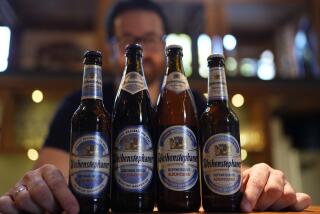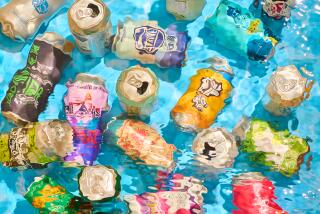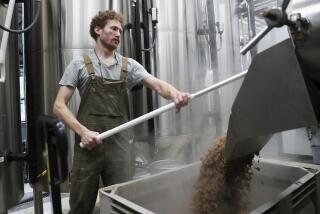Something’s A-Brew : Big Firms Turn to Red Beer to Meet Competition
- Share via
With adventurous, discriminating beer drinkers increasingly turning to specialty brews, big-name brewing companies are now seeing red.
Red beer, that is.
Red beers, so dubbed because of their distinctive hue, are the latest trend to hit the growing specialty beer market. Red Tail Ale, Red Nectar, Pete’s Wicked Red, St. Rogue Red and Boar’s Head Red are among the handcrafted red beers that are capturing the fancy of beer aficionados--to the chagrin of the industry giants.
Accordingly, some of the major brewers are adding their own versions. Industry leader Anheuser-Busch Co., in particular, has leaped headlong into the red-beer craze, introducing four red or specialty brews at different price levels in less than a year.
“Because consumers’ taste preferences are becoming so diverse, we’ve created a whole spectrum of specialty beers. It’s an emerging trend, and we want to be on the leading end of it,” said Tim Schoen, senior brand manager with Anheuser-Busch’s recently formed Specialty Brewing Group.
Like the light, dry and ice beers before it, red beer is the latest effort by major breweries to energize the lagging U.S. beer industry, whose sales have been virtually flat in recent years, analysts said.
“Major brewers are using red beers to fill the gap left by large brands that are declining,” said Mike Rietbrock, analyst at New York-based Smith, Barney & Co. He pointed out that Anheuser-Busch’s flagship Budweiser brand and Adolph Coors Co.’s mainstay Coors Light label have both slipped markedly in sales.
But while light, dry and ice beers were attempts by major brewers to create variations of mass market beers, red beers are their first attempt to compete directly with specialty brewers. To distance their red beer offerings from mainstream varieties, major brewers generally aren’t touting their company names on bottles. Instead, their offerings carry names like Red Wolf (produced by Anheuser-Busch) and Leinenkugel Red (by Miller Brewing Co.).
Market studies show that imports and local craft brews--old-fashioned, high-quality lagers and ales--are becoming the beers of choice for a growing number of pub-goers and social drinkers. New microbreweries and brew pubs are opening at a rate of about three per week, according to Bill Owens, publisher of American Brewer and Beer magazines. There are now about 536 microbreweries in the United States, up from only 75 or so in 1990 and less than a handful in 1983.
*
But will the large national breweries, which produce billions of barrels of beer a year, be able to recreate the unique, full-bodied flavor that characterizes a specialty beer? Some independent brewers remain skeptical.
Pete Slosberg, founder of Pete’s Brewing Co. in Palo Alto, said that although major breweries have the technical capability to produce a fine specialty beer, many of them are only half-committed.
“With these (brands), a lot of them are promoting an image more than a beer. They’re giving people the mystique but not following up with the flavor,” said spokeswoman Kristin Seuell of Pete’s.
But major brewers say their specialty offerings will equal or surpass in quality and taste those of their small-scale rivals--while in some cases still appealing to less-discriminating consumers.
Anheuser-Busch, for example, says its Red Wolf lager, first distributed nationally in February, is brewed “to appeal to the mainstream beer-drinking audience.” Its Elephant Red, brewed under license with Carlsberg at Labatt’s Montreal brewery, is designed to lure “the more discerning beer drinker,” explained brand manager Schoen.
The company’s Elk Mountain Red Lager and Elk Mountain Amber Ale fall somewhere in between, vying for shelf space with red varieties from Coors and Miller.
*
Coors introduced its first and only red beer, George Killian’s Irish Red, to the U.S. market back in 1981--making it for a long time the only major brewer in the red-beer segment. The company now plans to open its own brew pub in Denver’s new baseball stadium, said Coors’ spokeswoman Janet Rowe. The new Sandlot Brewery, scheduled to open at the end of this month, will showcase up to 10 varieties of handcrafted specialty beer, ranging from lager to stout. Coors also is considering stepping up its advertising by doing some new radio spots for Killian’s Red.
Miller has also tapped into the specialty beer rage, offering two red beers, Leinenkugel Red and Miller Reserve Amber Ale (also reddish), as well as Red Dog.
Miller’s Leinenkugel subsidiary introduced Leinenkugel Red in 1993 under the marketing slogan “the better red” to compete almost exclusively with Killian’s Red. But now the company, which touts its microbrewery roots, faces more competition than it bargained for, said Dick Leinenkugel, the company’s vice president of sales.
(BEGIN TEXT OF INFOBOX / INFOGRAPHIC)
Change Is Brewing
Domestic beer shipments by America’s largest brewers have remained flat over the past five years. Millions of barrels:
1990: 190.2
1991: 187.9
1992: 188.7
1993: 188.5
1994: 188.5
Shipments by specialty brewers--although still less than 1% of the total domestic market--have tripled over the same period. Millions of barrels:
1990: 0.63
1991: 0.85
1992: 1.2
1993: 1.7
1994: 2.1
Sources: Beer Marketer’s Insights, Institute for Brewing Studies. Researched by JENNIFER OLDHAM / Los Angeles Times


